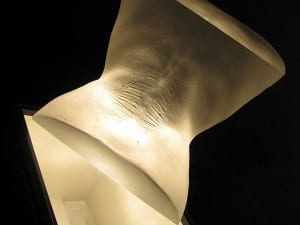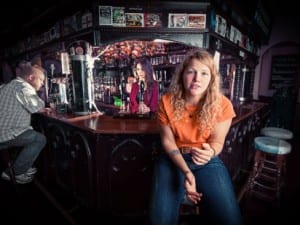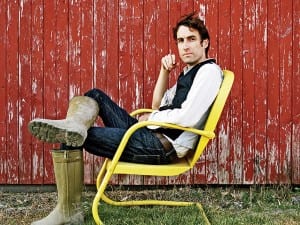Review by Jareh Das
Lebanese artist, theatre director, playwright and actor, Rabih Mroué presents his first UK solo show at iniva which centres around ongoing conflicts in Lebanon and the Middle East since the Lebanese Civil War. The Lebanese Civil work ended in 1990 and lasted for fifteen years. Its effect was devastating as it resulted in almost 300,000 civilian casualties as well as a mass displacement of Lebanese people.
For I, the Undersigned – The People are Demanding, a last minute intervention by the artist directly responds to the current political events and the socio-political climate in the Middle East; what one could describe as a modern uprising or people’s revolution. By replacing the exhibitions original title, I, the Undersigned with The People Are Demanding the exhibition places itself with the narrative of the contemporary situation in the Middle East. This new piece, on the window of the gallery, is a list of action words – to switch, to bitch, to prostitute, to gain, to win, to pin, to sin, to overthrow, to live, to love… The work is an acknowledgment of the ongoing renewal of collective unity, visually and physically linking the exhibition to the street and beyond. The iconic slogan ‘The People are Demanding’ is being heard in cities across the Middle East where a people’s revolution is unfolding in front of our eyes.
Je Veux Voir (I want to see) (2010), is an installation made up of a single looped video piece and collage mixed media installation. It is based on Mroué’s experience of co-starring with French actress Catherine Deneuve in a feature film in 2008. On a visit to South Lebanon, Deneuve went to see the aftermath of the 2007 Israeli attack on the South of Lebanon with Mroué for what was his first visit back to his native village. It depicts the actress walking through the rubble of the village, repetitively calling out ‘Rabih! Rabih!’. This was recorded at a point when Deneuve lost the artist, its effect poignant both in the physical and metaphysical symbolism of the aftermath of war. It’s as if it represents a displacement of the artist and a homecoming to a home that does not exist any longer, or exists in an alien form, due to the aftermath of war.
Grandfather, Father and Son, 2010, brings together material from the library of Mroué’s grandfather, a religious scholar turned Communist; a treatise written by his father during 1982, the year of the Israeli occupation of Lebanon, and a story by Rabih Mroué himself in 1989. This largely text based installation is an accumulation, a certain kind which dwells on the personal history of the artist. By telling personal stories or biographical stories, Mroué could be viewed as assuming the role of storyteller although he aims to isolate often overlooked, yet vital strands, within the broader tendency: the use of story form in contemporary art as a means of comprehending and conveying recent social and political events.
Although seen as a biographical piece, Mroué describes his practice and approach to art as ‘biographia‘, a concept or proposition that is more open ended which does not have a beginning or end. It is non-linear but more fragmental, a fusion of fiction and reality. Biographia presents a more circular reading of history as opposed to one that has a predetermined beginning and end. Rabih doesn’t think art should be involved in ethics, in the context of the Middle East, he feels the history and current conflicts suspend it from the ethical. How can one describe an area of conflict as one that responds to ethics, when war invariably demands choosing a side, i.e. a dichotomy between good or bad. In a state of urgency of conflicts, there is no ethical and he feels, art should play opposite of ethical, postpone these concerns and present the situation as best as it can, in this case continually reference the phrase The People are Demanding…Change, Progress, Fairness… The list goes on.
I, the Undersigned – The People are Demanding continues at Iniva until May 14. For more information please visit their website.
Image:
Je Veux Voir: installation view at Rivington Place
Courtesy the artist and Thierry Bal





